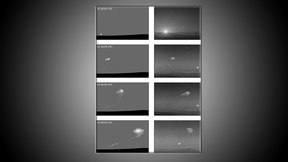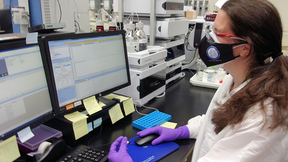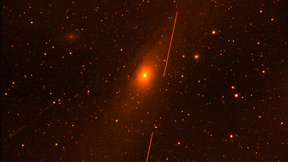Back
A team from Lawrence Livermore National Laboratory (LLNL) successfully collected data from the recent operational test of an Air Force Global Strike Command unarmed Minuteman III intercontinental ballistic missile (ICBM) launched from Vandenberg Space Force Base. The purpose of the ICBM test launch program is to validate and verify the safety, security, effectiveness and…
A team from Lawrence Livermore National Laboratory (LLNL) successfully collected data from the recent operational test of an Air Force Global Strike Command unarmed Minuteman III intercontinental ballistic missile (ICBM) launched from Vandenberg Space Force Base. The purpose of the ICBM test launch program is to validate and verify the safety, security, effectiveness and…
For decades, understanding the behavior of a nuclear mushroom cloud was done with careful analysis of observations made during the testing era. Old photos, outdated film and incomplete weather data made precise calculations difficult. Now, with results published in Atmospheric Environment, Lawrence Livermore National Laboratory (LLNL) scientists are improving our…
It wasn’t an easy road, but Lawrence Livermore National Laboratory (LLNL) Forensic Science Center scientists earned an “A” grade in the Organisation for the Prohibition of Chemical Weapons’ (OPCW) recent biomedical proficiency test. In addition to the usual complexity of the sample preparations and analysis, the Livermore scientists received their proficiency test samples…
Bradley Wallin has been named Lawrence Livermore National Laboratory’s (LLNL’s) principal associate director (PAD) for Weapons and Complex Integration (WCI), Lab Director Kimberly Budil announced today. In this role, Wallin will lead the Laboratory's nuclear weapons program in its responsibilities to support U.S. strategic deterrence by assuring the safety, security and…
A polymer production enclave, in partnership with the Kansas City National Security Campus (KCNSC) and Lawrence Livermore National Laboratory (LLNL), is on budget and on schedule to bring modern technology into the Nuclear Security Enterprise. The enclave will enable rapid development of design and production processes of polymer parts for modernization programs. This…
A polymer production enclave, in partnership with the Kansas City National Security Campus (KCNSC) and Lawrence Livermore National Laboratory (LLNL), is on budget and on schedule to bring modern technology into the Nuclear Security Enterprise. The enclave will enable rapid development of design and production processes of polymer parts for modernization programs. This…
Several Lawrence Livermore National Laboratory (LLNL) scientists played key roles in the 25th annual meeting of the Nuclear Forensics International Technical Working Group (ITWG), which met last month. The event, which was conducted in a virtual setting for the first time, was attended by more than 100 experts from 30 countries and highlighted the group’s notable…
When the U.S. Space Force’s Tactically Responsive Launch-2 (TacRL-2) mission launched from Vandenberg Space Force Base on June 13, it carried a payload designed and built in record time by Lawrence Livermore National Laboratory (LLNL). LLNL provided a three-mirror reflective telescope and sensor for the payload, which they designed, integrated, tested and delivered within…
Thousands of images of Earth and space have been taken by a compact space imaging payload developed by Lawrence Livermore National Laboratory (LLNL) researchers and its collaborator Tyvak Nano-Satellite Systems. Known as GEOStare2, the payload has two space telescopes that together have taken more than 4,500 pictures for space domain awareness, astronomy and Earth…
Lawrence Livermore National Laboratory (LLNL) joins in the celebration of the U.S. Army birthday on June 14. Created in 1775, the army originally consisted of volunteer soldiers with roots to the Continental Army — and was formed to fight the Revolutionary War. Today, as the largest branch of the country’s military, the proud men and women of the U.S. Army continue to…
The Advanced Data Analytics for Proliferation Detection (ADAPD) program held a two-day virtual technical exchange meeting recently. The goal of the meeting was to highlight the science-based and data-driven analysis work conducted by ADAPD to advance the state-of-the-art to accelerate artificial intelligence (AI) innovation and develop AI-enabled systems to enhance the…
Ten scientists from Lawrence Livermore National Laboratory (LLNL) last week took part in the 7th IAA Planetary Defense Conference (PDC), hosted by the United Nations Office for Outer Space Affairs in cooperation with the European Space Agency. Megan Bruck Syal, who helped lead the Lab’s participation in the event and who also was a conference session chair, said this year…
A research collaboration between Lawrence Livermore National Laboratory (LLNL) and the Air Force Institute of Technology (AFIT) investigates how the neutron energy output from a nuclear device detonation can affect the deflection of an asteroid. Scientists compared the resulting asteroid deflection from two different neutron energy sources, representative of fission and…
Researchers from Lawrence Livermore National Laboratory (LLNL) and their colleagues who help them commercialize technologies have won three national technology transfer awards this year. The trio of awards, from the Federal Laboratory Consortium (FLC), represent the most national awards that LLNL has ever won in one year’s competition over the past 36 years. Two of the…
When Mona Dreicer learned she had been tapped to receive one of the National Nuclear Security Administration’s (NNSA) top awards, she had two reactions – she was surprised and she was honored. The deputy director of the Lab’s Center for Global Security Research (CGSR) for six years until her retirement in 2020, Dreicer has been named a recipient of the NNSA Administrator’s…
Ten years ago today, on March 11, 2011, a 9.0 Richter-scale earthquake and tsunami in Japan resulted in severe damage to the Fukushima Dai-ichi nuclear power plant and also led to releases of radioactivity into the environment. That same day, the U.S. Department of Energy (DOE) activated Lawrence Livermore National Laboratory’s National Atmospheric Release Advisory Center …
Whether working informally or through a collaboration agreement, Lawrence Livermore National Laboratory (LLNL) and the Monterey-based Naval Postgraduate School (NPS) have enjoyed an enduring relationship for more than two decades. While the two institutions have worked together informally for years, until recently they had only one memorandum of understanding (MOU)…
What are the next world-class, game-changing concepts and technologies that will address the most important questions in astrophysics or planetary science? Lawrence Livermore National Laboratory (LLNL) researchers will soon be better equipped to answer this question with the launch this month of a new Space Science Institute (SSI), intended to boost cross-discipline…
Nearly a year into piloting a major scientific institution through one of the most taxing and disruptive global events in modern history, outgoing Livermore Lab Director Bill Goldstein is ready for a vacation. One of Goldstein’s first orders of business following his retirement on March 1 is returning to the lush slopes, coffee plantations and sandy beaches of Kona, Hawaii…























